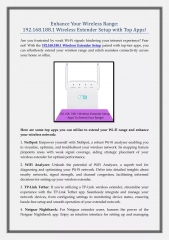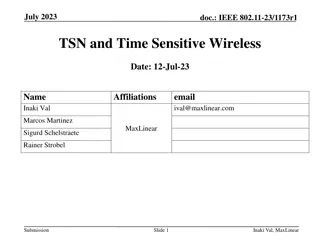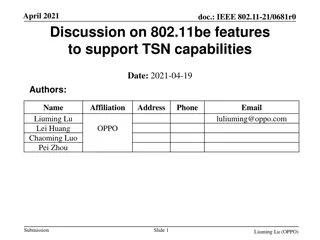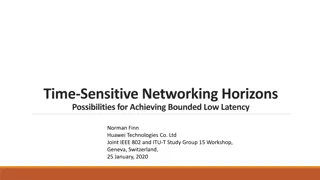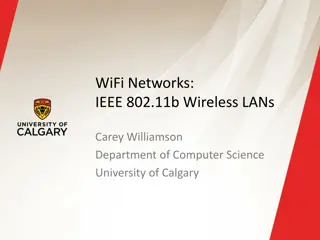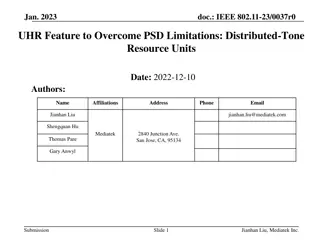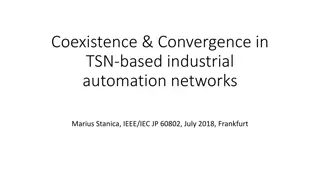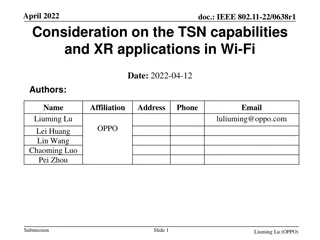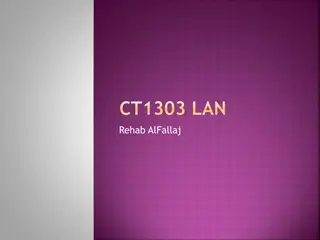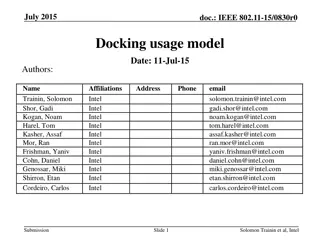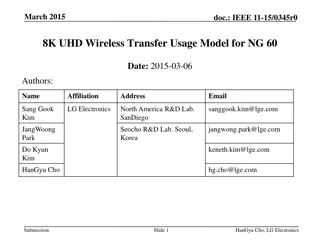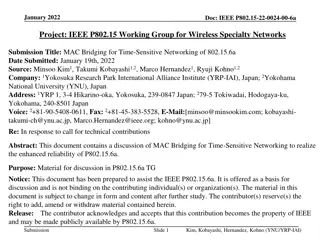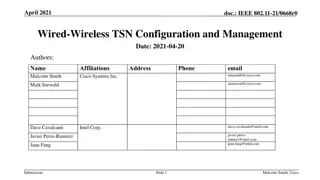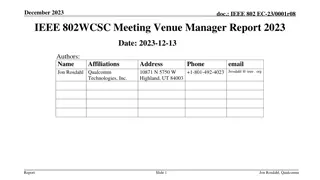Wireless TSN in 802.11: New Requirements and Integration with 802.1
This document discusses the extension of TSN capabilities from wired to wireless networks, focusing on potential enhancements for 802.11be and integration with Ethernet-based TSN standards. It covers topics such as time-sensitive applications, TSN toolbox overview, status of TSN capabilities supported by 802.11, and wired-wireless TSN bridging enabled by 802.11. The presentation emphasizes collaboration between 802.11be and 802.1 for improved deterministic performance over Wi-Fi.
Download Presentation

Please find below an Image/Link to download the presentation.
The content on the website is provided AS IS for your information and personal use only. It may not be sold, licensed, or shared on other websites without obtaining consent from the author. Download presentation by click this link. If you encounter any issues during the download, it is possible that the publisher has removed the file from their server.
E N D
Presentation Transcript
April 2021 doc.: IEEE 802.11-21/628r0 Wireless TSN in 802.11 and New Requirements for 802.11be and 802.1 Date: 2021-04-08 Authors: Name Dave Cavalcanti Affiliations Intel Corporation Address Hillsboro, OR, USA Phone email Ganesh Venkatesan Juan Fang Dibakar Das Laurent Cariou Malcolm Smith Cisco Systems Inc. Maik Seewald Submission Slide 1 Dave Cavalcanti, Intel Corporation
April 2021 doc.: IEEE 802.11-21/628r0 Introduction There is increasing interest in extending TSN capabilities and standards from wired to wireless Many time-sensitive applications can benefit from deterministic performance over Wi-Fi Support for TSN enhancements and integration with Ethernet-based TSN is within the scope of the 802.11be project This presentation reviews the TSN features supported by 802.11, discusses open challenges and topics for further collaboration between 802.11be and 802.1 Submission Slide 2 Dave Cavalcanti, Intel Corporation
April 2021 doc.: IEEE 802.11-21/628r0 TSN toolbox Overview Example TSN tools (not a complete list) extended to 802.11 and relevant 802.11 capabilities Redundancy (802.1CB) TSN toolbox Time synchronization (802.1AS profile of IEEE 1588) 802.1AS over 802.11 TM, FTM 802.11be Multi-link Redundant time (802.1AS-Rev) Synchronization Reliability Bounded Latency Time-aware scheduling (802.1Qbv) TSN Config (802.1Qcc) 802.1Q bridging (802.11ak) Scheduling (802.11ax) QoS Enhancements/low latency (802.11be) Resource Mgmt Stream reservation (802.1Qat) Submission Slide 3 Dave Cavalcanti, Intel Corporation
April 2021 doc.: IEEE 802.11-21/628r0 Status of TSN capabilities supported by 802.11 Relevant 802.1 and 802.11 features and specifications Potential topics for 802.11be and/or 802.1 Integration with 802.1Q networks 802.1Q and 802.11ak - Traffic Stream Classification 802.1Q VLAN ID, 802.11 TCLAS mask for 802.1Q Mapping 802.1 TSN flow to traffic flow in 802.11be STAs to receive prioritized treatment (ongoing QoS/low latency discussions in 11be) Time Synchronization 802.1AS and 802.11 TM and FTM - Bounded latency 802.1Qbv/Qav over 802.11 MAC, scheduling enhancements in 11ax, Predictable low latency via restricted SP in 11be Enhance Time-aware scheduling in the 802.11be MAC Wireless-aware TSN configuration to handle dynamics of the wireless channel Reliability 802.1CB 802.1CB over 802.11be MLD Configuration and Resource management Wired-Wireless TSN configuration models Submission Slide 4 Dave Cavalcanti, Intel Corporation
April 2021 doc.: IEEE 802.11-21/628r0 Wired-Wireless 802.1 TSN bridging enabled by 802.11 CUC CNC 4.3.28.3.3 Infrastructure BSS with general links and Figure 4-15 in IEEE P802.11 REVmd D5.0 End Device End Device TSN Bridge Wired TSN Domain End Device End Device Wireless TSN Access Point Wireless TSN Domain Control plane entities in a centralized management model (802.1 Qcc): CNC: Central Network Configuration CUC: Central User Configuration Submission Slide 5 Dave Cavalcanti, Intel Corporation
April 2021 doc.: IEEE 802.11-21/628r0 Traffic stream classification and differentiation Classifying and differentiating Time-sensitive streams from other flows is a fundamental TSN requirement 802.1Q VLAN tag is used for traffic classification Up to 8 traffic classes (queues) per port defined by the Priority Code Point (PCP) field Traffic differentiation is used by other TSN features (e.g., 802.1Qbv traffic shaping) 802.11 Stations can identify VLAN tag and PCP fields 802.11 TCLAS defines an 802.1Q classifier (Already defined, no spec changes needed) Submission Slide 6 Dave Cavalcanti, Intel Corporation
April 2021 doc.: IEEE 802.11-21/628r0 Time Synchronization (802.1AS) 802.1AS Synchronization across wired-wireless TSN Application example: A PLC s control cycle can be synchronized with other PLCs/Sensors/Actuators over Ethernet and 802.11 links Control plane CUC Data plane (wired TSN) Data plane (wireless TSN) Time-Aware traffic shaping (802.1Qbv) operates based on the same reference clock on wired and wireless links CNC Grand Master 802.11 defined MAC specific support for 802.1AS: End Device End Device Timing Measurement (TM) IEEE802.11-2012 AP TSN Bridge TSN Bridge Listener Talker (WTSN Bridge) Fine Timing Measurement (FTM) IEEE802.11-2016 Wired TSN Domain Wireless TSN Domain Submission Slide 7 Dave Cavalcanti, Intel Corporation
April 2021 doc.: IEEE 802.11-21/628r0 Bounded latency 802.1Qbv is a TSN tool to achieve determinism via scheduling resources Traffic Class #7 Traffic Class #6 Traffic Class #5 Traffic Class #0 T0 Example Schedule T0+ 10ms - - 1 ms Timing Data Gate Control 500 s (Guard band) 8.5 ms (gate open) Other traffic Gate Gate Gate Gate (gate open) Time-critical Transmission Selection To support 802.1Qbv, the 802.11 TSN domain needs to deliver packets within deadlines (bounded latency) at deterministic time intervals with high reliability Need predictable access for time-critical packets as part of known (periodic) traffic flows Submission Slide 8 Dave Cavalcanti, Intel Corporation
April 2021 doc.: IEEE 802.11-21/628r0 Current support and gaps for 802.1Qbv in 802.11be 802.11ax scheduled operation enables better control of latency to support 802.1Qbv Gaps: 1. 802.1Qbv configuration should be provided to the 802.11be MAC as requirements/input (e.g., for scheduling of Restricted TWT SPs) Time-sensitive frames within the 802.11 MAC may be delayed if sharing a queue with other traffic (head of the line blocking & randomness) 11be MAC need to isolate frames and consider per frame deadlines (time-aware) Time-sensitive frame The Restricted TWT (being defined in 802.11be) can enhance channel access for more deterministic latency 2. Restricted TWT SP for low latency traffic SME-MLME SAP : Gate Open for time-critical traffic Time-Aware (Scheduling, rTWT policing) : Gate Open for other traffic HOL Blocking/delay The scheduled Restricted TWT SPs must align with the 802.1Qbv schedule for the network Pause/resume EDCAFs Submission Slide 9 Dave Cavalcanti, Intel Corporation
April 2021 doc.: IEEE 802.11-21/628r0 Reliability (802.1CB and 802.11be MLD) 802.1CB Frame Replication and Elimination for Reliability (FRER) 802.1CB over two MAC/PHY interfaces (multiple transmissions and duplicate elimination) Integration of 802.11be MLD with 802.1CB (multi-link transmissions and duplicate elimination) Upper layer Upper layer 802.1CB FRFE 802.1CB FRER Upper MLD MAC Multi-link transmissions Media specific Dual MAC/PHY (802.3, 802.11) MAC MAC .11be Lower MAC .11be Lower MAC PHY PHY .11be PHY .11be PHY Link 2 Link 1 Link 2 Link 1 1. Two ports are shown as two interfaces to 802.1CB 1. 802.11be MLD supports transmissions over multiple links and handles duplicate elimination 2. 802.1CB introduces Redundancy-Tag and handles frame duplication and elimination 2. 802.1CB can generate a stream with redundancy-tag 3. Tx MLD trigger multi-link transmissions based on the redundancy tag 4. Rx MLD eliminates duplicates based on per MLD BA agreement Submission Slide 10 Slide 10 Dave Cavalcanti, Intel Corporation
April 2021 doc.: IEEE 802.11-21/628r0 Configuration and Resource Management The time-aware schedule needs to take into account dynamic link states in 802.11 Short term changes to the wireless link cannot be easily managed at the central TSN scheduler - CNC 802.1Qbv schedules cannot change fast enough Short term changes in the wireless channel should be handled by the 802.11 MAC, using 802.11 tools (scheduling, MCS/RU allocations, MLO, rTWT, ) More flexible configuration models Submission Slide 11 Dave Cavalcanti, Intel Corporation
April 2021 doc.: IEEE 802.11-21/628r0 Conclusions 802.11 is already part of the 802.1 TSN architecture 802.1 and 802.11 have been collaborating for specifying support required in 802.11 for several TSN features 802.11be is introducing new latency and reliability enhancements Introducing more wireless-awareness in some of the 802.1 Standards can enable more efficient Wireless TSN operation, configuration and management, for instance: 802.1CB aware of 802.11be MLD 802.1Q configuration aware of wireless links Submission Slide 12 Dave Cavalcanti, Intel Corporation


